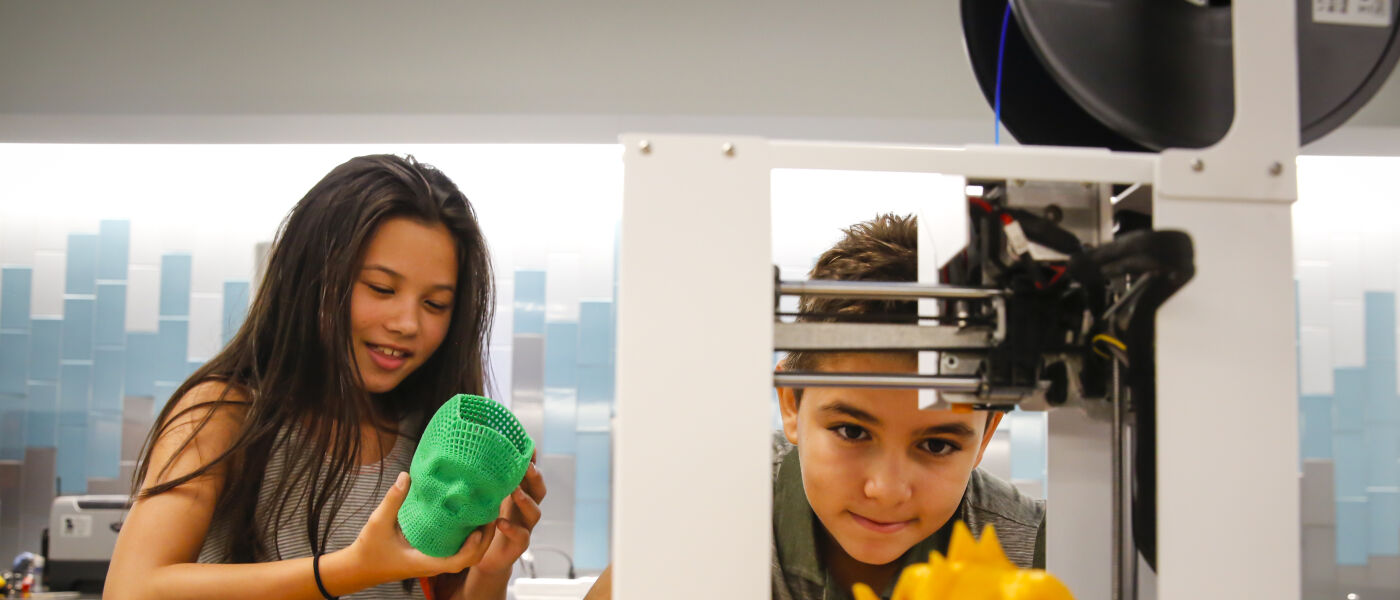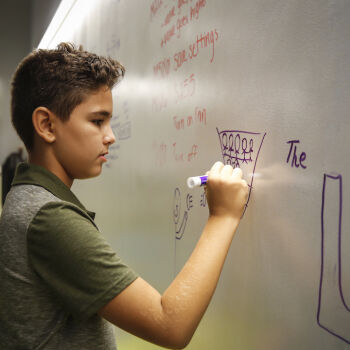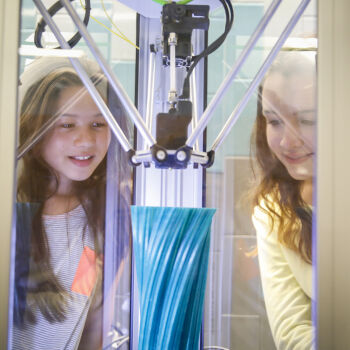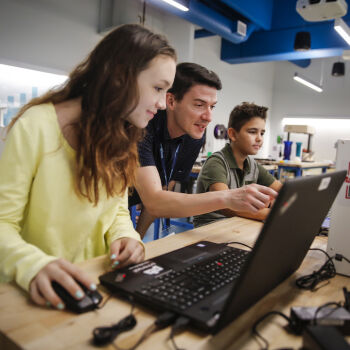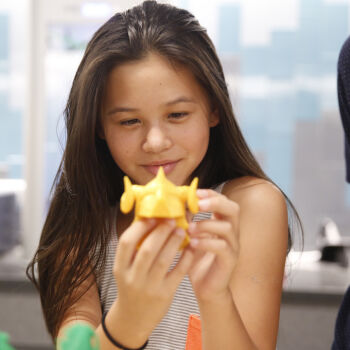Maker & Tech
LSC’s MakerLab and Tech & Design Studio bring technology and creativity to life.
MakerLab workshops celebrate and encourage the creative, curious, and inventive spirits that all students have. The maker culture is at the heart of these workshops where students will use 3-D software to design innovative solutions for tomorrow’s problems.
Tech & Design Studio workshops introduce exciting technology skills to students. Each student works to apply computational thinking and design principles to identify solutions or create dynamic projects.
Programs must be booked in advance. Email us at groups@lsc.org for more details or to make a reservation. Please include your name, school or organization, group size, preferred dates and any other details or questions. An LSC team member will respond to you soon!
Grades Pre-K – 2
Coding with Kubo (Five Sessions; Each 45 Minutes)
Available at LSC or at your school. Work with our very special robot, Kubo, to get an introduction to the basics of coding. From understanding coding as a language and building functions to creating loops and solving puzzles, you’ll have a blast coding with Kubo. Alignment to NJSLS - Algorithms & Programming: 8.1.2.AP.1 Model daily processes by creating and following algorithms to complete tasks. 8.1.2.AP.3 Create programs with sequences and simple loops to accomplish tasks. 8.1.2.AP.4 Break down a task into a sequence of steps.
Biomimicry to Me (Five Sessions; Each 45 Minutes)
Available at LSC or at your school. Everyone loves animals! But did you know that we can copy our favorite animals’ special qualities to create inventions? That’s called biomimicry! In this series, learn all about what adaptations are, how they help animals survive in their unique environments, and how we mimic these solutions to solve everyday problems. Help apply what you learn throughout the series to solve a problem and design a unique solution with 3D printing pens. Alignment to NJSLS - Science: 1-LS1-1 Use materials to design a solution to a human problem by mimicking how plants and/or animals use their external parts to help them survive, grow, and meet their needs. K-2-ETS1-3 Analyze data from tests of two objects designed to solve the same problem to compare the strengths and weaknesses of how each performs.
Grades 3 – 5
Ecology through Game Design (45 - 60 Minutes)
Available online or at LSC. Explore ecosystems, food chains, and more in a whole new way. Build and play games using the Scratch platform to investigate concepts in ecology. Alignment to NJSLS - Science: 5-LS2-1 Develop a model to describe the movement of matter among plants, animals, decomposers, and the environment. Alignment to NJSLS - Computer Science and Design Thinking: 8.2.5.ITH.3 Analyze the effectiveness of a new product or system and identify the positive and/or negative consequences resulting from its use. 8.2.5.NT.3 Redesign an existing product for a different purpose in a collaborative team. 8.2.5.NT.4 Identify how improvement in the understanding of materials science impacts technologies. Connections to NJSLS – English Language Arts: RI.5.7 Draw on information from multiple print or digital sources, demonstrating the ability to locate an answer to a question quickly or to solve a problem efficiently. (5-LS2-1) Connections to NJSLS – Mathematics: MP.2 Reason abstractly and quantitatively. (5-LS2-1) MP.4 Model with mathematics. (5-LS2-1)
Coding Virtual Rovers (45 Minutes)
Available online or at LSC. Want to see your code come to life? Using a user-friendly, web-based computer science coding program, create a code to navigate a virtual rover through a maze. Your challenge, should you choose to accept it, is to try to make your code as efficient as it is effective. Alignment to NJSLS - Science: 3-5-ETS1-3 Plan and carry out fair tests in which variables are controlled and failure points are considered to identify aspects of a model or prototype that can be improved. 3-PS2-2 Make observations and/or measurements of an object’s motion to provide evidence that a pattern can be used to predict future motion. Alignment to NJSLS - Computer Science & Design Thinking: 8.1.5.AP.4: Break down problems into smaller, manageable sub-problems to facilitate program development. 8.1.5.DA.5 Propose cause and effect relationships, predict outcomes, or communicate ideas using data. 8.1.5.AP.1: Compare and refine multiple algorithms for the same task and determine which is the most appropriate. 8.1.5.AP.3: Create programs that include sequences, events, loops, and conditionals. Connections to NJSLS - Mathematics: MP.2 Reason abstractly and quantitatively.
Digital Animation Series (Three to Five 45-Minute Sessions)
Available online or at LSC. Animation is a series of images, each slightly different from the last, shown in sequence. Artists and animators can take a vision and bring it to life. In this series, learn the core principles of animation, use Pixilart software tools, and apply your new animation skills to fix design errors and improve a product. Alignment to NJSLS - Science: 3-5-ETS1-3 Plan and carry out fair tests in which variables are controlled and failure points are considered to identify aspects of a model or prototype that can be improved. Alignment to NJSLS - Computer Science and Design Thinking: 8.1.5.DA.3: Organize and present collected data visually to communicate insights gained from different views of the data. 8.2.5.ED.3 Follow step-by-step directions to assemble a product or solve a problem, using appropriate tools to accomplish the task. Connections to NJSLS - English Language Arts: W.5.7 - Conduct short research projects that use several sources to build knowledge through investigation of different aspects of a topic. Connections to NJSLS – Mathematics: MP.2 Reason abstractly and quantitatively.
Digital Art Studio (45-60 Minutes, now available in Spanish)
Available online or at LSC. Explore color theory, lighting, and animation to create digital art or animation. We’ll use an intuitive online S.T.E.A.M. toolset that’s limited only by your imagination. Alignment to NJSLS - Science: 3-5-ETS1-2 Generate and compare multiple possible solutions to a problem based on how well each is likely to meet the criteria and constraints of the problem. Connections to NJSLS – Mathematics: MP.2 Reason abstractly and quantitatively. MP.5 Use appropriate tools strategically. Alignment to NJSLS - Computer Science and Design Thinking: 8.1.5.DA.3: Organize and present collected data visually to communicate insights gained from different views of the data. 8.2.5.ED.3: Follow step-by-step directions to assemble a product or solve a problem, using appropriate tools to accomplish the task. Connections to NJSLS - English Language Arts: W.5.7 Conduct short research projects that use several sources to build knowledge through investigation of different aspects of a topic.
Intro to 3D Design with Tinkercad (45-60 Minutes)
Available online or at LSC. Learn the basics of 3D design using the open-source software Tinkercad to design and create a custom desk name plate. Each student will need a computer and a Tinkercad account. Alignment to NJSLS - Science: 3-5-ETS1-1 Define a simple design problem reflecting a need or a want that includes specified criteria for success and constraints on materials, time, or cost. Connections to NJSLS - Mathematics: MP.4 - Model with mathematics. Alignment to NJSLS - Computer Science and Design Thinking: 8.2.5.ITH.2 Evaluate how well a new tool has met its intended purpose and identify any shortcomings it might have. 8.2.5.ED.2: Collaborate with peers to collect information, brainstorm to solve a problem, and evaluate all possible solutions to provide the best results with supporting sketches or models.
Intro to Game Design (45-60 Minutes)
Available online or at LSC. Design custom characters, animations, and behaviors for video games. Use the platform Scratch to build a foundation for computational thinking, an essential skill in today’s tech-driven world. Alignment to NJSLS - Science: 3-5-ETS1-3 Plan and carry out fair tests in which variables are controlled and failure points are considered to identify aspects of a model or prototype that can be improved. Alignment to NJSLS - Computer Science and Design Thinking: 8.1.5.AP.3: Create programs that include sequences, events, loops, and conditionals. 8.1.5.AP.6: Develop programs using an iterative process, implement the program design, and test the program to ensure it works as intended. Connections to NJSLS - Mathematics: MP.2 Reason abstractly and quantitatively. MP.4 Model with mathematics.
Grades 6 – 8
Arduino Circuits (45-60 Minutes)
Available online or at LSC. Learn about circuitry and how to code for the microcontroller Arduino. This program is great for beginners but flexible enough to provide additional challenges for more knowledgeable students. Alignment to NJSLS - Science: MS-ETS1-4 Develop a model to generate data for iterative testing and modification of a proposed object, tool, or process such that an optimal design can be achieved. Alignment to NJSLS - Computer Science and Design Thinking: 8.2.8.ED.1 Evaluate the function, value, and aesthetics of a technological product or system, from the perspective of the user and the producer. Connections to NJSLS - Mathematics: MP.2 Reason abstractly and quantitatively. Connections to NJSLS - Computer Science and Design Thinking: 8.18.CS.4 Systematically apply troubleshooting strategies to identify and resolve hardware and software problems in computing systems. 8.1.8.AP.2 Create clearly named variables that represent different data types and perform operations on their values.
Coding Virtual Rovers (45 Minutes)
Available online or at LSC. Using a user-friendly, web-based computer science coding program, create a code to navigate a virtual rover through a maze. Your challenge, should you choose to accept it, is to try to make your code as efficient as it is effective. Alignment to NJSLS - Science: MS-ETS1-2 Evaluate competing design solutions using a systematic process to determine how well they meet the criteria and constraints of the problem. Connections to NJSLS - Mathematics: MP.2 Reason abstractly and quantitatively. NJSLS - Computer Science and Design Thinking: 8.1.8.AP.3: Design and iteratively develop programs that combine control structures, including nested loops and compound conditionals. 8.1.8.AP.2: Create clearly named variables that represent different data types and perform operations on their values.
Design Thinking with Tinkercad (60-75 Minutes)
Available online or at LSC. Engage in the online digital creation of 3D models and learn how to create pieces designed for a community with needs. At LSC, our Monoprice Mini Select printers print a prototype of your model that’s yours to keep. Alignment to NJSLS - Science: MS-ETS1-4 Develop a model to generate data for iterative testing and modification of a proposed object, tool, or process such that an optimal design can be achieved. Alignment to NJSLS - Computer Science and Design Thinking: 8.2.8.ED.1 Evaluate the function, value, and aesthetics of a technological product or system, from the perspective of the user and the producer. 8.1.8.ED.3 Develop a proposal for a solution to a real-world problem that includes a model (e.g., physical prototype, graphical/technical sketch). Connections to NJSLS - Mathematics: MP.2 Reason abstractly and quantitatively.
Digital Animation Series (Three to Five Sessions; Each 45 Minutes)
Available online or at LSC. Animation is a series of images, each slightly different from the last, shown in sequence. Artists and animators can take a vision and bring it to life. In this series, learn the core principles of animation, use Pixilart software tools, and apply your new animation skills to fix design errors and improve a product. Alignment to NJSLS - Science: MS-ETS1-3 Analyze data from tests to determine similarities and differences among several design solutions to identify the best characteristics of each that can be combined into a new solution to better meet the criteria for success. Alignment to NJSLS - Computer Science: 8.2.8.ED.3 Develop a proposal for a solution to a real-world problem that includes a model (e.g., physical prototype, graphical/technical sketch). Connections to NJSLS - Mathematics: MP.2 Reason abstractly and quantitatively.
Digital Art Studio (Now available in Spanish, 45-60 Minutes)
Available online or at LSC. Explore color theory, lighting, and animation to create digital art or animation. We’ll use an intuitive online S.T.E.A.M. toolset that’s limited only by your imagination. Alignment to NJSLS - Science: MS-ETS1-3 Analyze data from tests to determine similarities and differences among several design solutions to identify the best characteristics of each that can be combined into a new solution to better meet the criteria for success. Alignment to NJSLS - Computer Science and Design Thinking: 8.2.8.ED.1 Evaluate the function, value, and aesthetics of a technological product or system, from the perspective of the user and the producer. Connections to NJSLS - Mathematics: MP.2 Reason abstractly and quantitatively.
Intro to 3D Design with Tinkercad (45-60 Minutes)
Available online or at LSC. Engage in the digital creation of 3D models and learn how to create intricate pieces designed for 3D printing using Autodesk Tinkercad. Alignment to NJSLS - Science: MS-ETS1-4 Develop a model to generate data for iterative testing and modification of a proposed object, tool, or process such that an optimal design can be achieved. Alignment to NJSLS - Computer Science and Design Thinking: 8.2.8.ED.1 Evaluate the function, value, and aesthetics of a technological product or system, from the perspective of the user and the producer. Connections to NJSLS - English Language Arts: SL.8.5 Integrate multimedia and visual displays into presentations to clarify information, strengthen claims and evidence, and add interest. Connections to NJSLS - Mathematics: MP.2 Reason abstractly and quantitatively.
Intro to Game Design (45-60 Minutes)
Available online or at LSC. Design custom characters, animations, and behaviors for video games. Use the platform Scratch to build a foundation for computational thinking, an essential skill in today’s tech-driven world. Alignment to NJSLS - Science: MS-ETS1-2 Evaluate competing design solutions using a systematic process to determine how well they meet the criteria and constraints of the problem. Alignment to NJSLS - Computer Science and Design Thinking: 8.2.8.ED.1 Evaluate the function, value, and aesthetics of a technological product or system, from the perspective of the user and the producer. 8.2.8.ED.4 Investigate a malfunctioning system, identify its impact, and explain the step-by-step process used to troubleshoot, evaluate, and test options to repair the product in a collaborative team. Connections to NJSLS - Mathematics: MP.2 Reason abstractly and quantitatively. 7.EE.3 Solve multi-step real-life and mathematical problems posed with positive and negative rational numbers in any form (whole numbers, fractions, and decimals), using tools strategically. Apply properties of operations to calculate with numbers in any form; convert between forms as appropriate; and assess the reasonableness of answers using mental computation and estimation strategies.
Mars Terraforming (60-75 Minutes)
Available at LSC. Can humans overcome Mars’ harsh environment and live there one day? Design a habitat for life on Mars based on a topographic map given to you by LSC that resembles an actual Martian location. Modify the terrain as needed, build your 3D model of your Martian home and share your methods. Alignment to NJSLS - Science: MS-ETS1-2 Evaluate competing design solutions using a systematic process to determine how well they meet the criteria and constraints of the problem. Connections to NJSLS - English Language Arts: SL.8.5 Integrate multimedia and visual displays into presentations to clarify information, strengthen claims and evidence, and add interest. Alignment to NJSLS - Computer Science and Design Thinking: 8.2.8.ED.1 Evaluate the function, value, and aesthetics of a technological product or system, from the perspective of the user and the producer. 8.2.8.ED.2 Identify the steps in the design process that could be used to solve a problem. Connections to NJSLS - Mathematics: MP.2 Reason abstractly and quantitatively.
Grades 9 – 12
Mars Terraforming (60-75 Minutes)
Available at LSC. Can humans overcome Mars’ harsh environment and live there one day? Design a habitat for life on Mars based on a topographic map given to you by LSC that resembles an actual Martian location. Modify the terrain as needed, build your 3D model of your Martian home and share your methods. Alignment to NJSLS - Science: HS-ESS3-2 Evaluate competing design solutions for developing, managing, and utilizing energy and mineral resources based on cost-benefit ratios. Connections to NJSLS - Mathematics: MP.2 Reason abstractly and quantitatively. Alignment to NJSLS - Computer Science and Design Thinking: 8.2.12.ITH.2 Propose an innovation to meet future demands supported by an analysis of the potential costs, benefits, trade-offs, and risks related to the use of the innovation. 8.2.12.ED.2: Create scaled engineering drawings for a new product or system and make modification to increase optimization based on feedback
Coding Virtual Rovers (60-75 Minutes)
Available online or at LSC. Create a code to navigate a virtual rover through a coral reef and clean up garbage using a user-friendly, web-based block coding program. Your challenge, should you choose to accept it, is to try to make your code as efficient as it is effective. Alignment to NJSLS - Science: HS-ETS1-4 Use a computer simulation to model the impact of proposed solutions to a complex real-world problem with numerous criteria and constraints on interactions within and between systems relevant to the problem. Alignment to NJSLS - Computer Science and Design Thinking: 8.1.12.AP.1: Design algorithms to solve computational problems using a combination of original and existing algorithms. Connections to NJSLS – Mathematics: MP.2 Reason abstractly and quantitatively. MP.4 Model with mathematics.
Design Thinking with Tinkercad (60-75 Minutes)
Available online or at LSC. Engage in the online digital creation of 3D models and learn how to create pieces designed for a community’s needs. At LSC, our Monoprice Mini Select printers print a prototype of your model that’s yours to keep. Alignment to NJSLS - Science: HS-ETS1-2 Design a solution to a complex real-world problem by breaking it down into smaller, more manageable problems that can be solved through engineering. Connections to NJSLS - Mathematics: MP.4 Model with mathematics. Alignment to NJSLS - Computer Science and Design Thinking: 8.2.12.NT.2 Redesign an existing product to improve form or function.
Digital Animation Series (Three to Five 45-60 Minute Sessions)
Available online or at LSC. Animation is a series of images, each slightly different from the last, shown in sequence. Artists and animators can take a vision and bring it to life. In this series, learn the core principles of animation, use Pixilart software tools, and apply your new animation skills to fix design errors and improve a product. Alignment to NJSLS - Science: HS-ETS1-2 Design a solution to a complex real-world problem by breaking it down into smaller, more manageable problems that can be solved through engineering. Alignment to NJSLS - Computer Science and Design Thinking: 8.2.12.ED.5 Evaluate the effectiveness of a product or system based on factors that are related to its requirements, specifications, and constraints (e.g., safety, reliability, economic considerations, quality control, environmental concerns, manufacturability, maintenance and repair, ergonomics). Connections to NJSLS - Mathematics: MP.4 Model with mathematics.
Intro to 3D Design with Tinkercad (45-60 Minutes)
Available online or at LSC. Engage in the digital creation of 3D models and learn how to create intricate pieces designed for 3D printing using Autodesk Tinkercad. Alignment to NJSLS - Science: HS-ETS1-2 Design a solution to a complex real-world problem by breaking it down into smaller, more manageable problems that can be solved through engineering. Alignment to NJSLS - Computer Science and Design Thinking: 8.2.12.NT.2 Redesign an existing product to improve form or function. Connections to NJSLS - Mathematics: MP.4 Model with mathematics.
